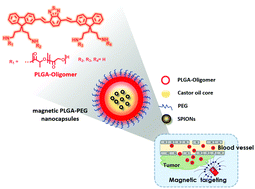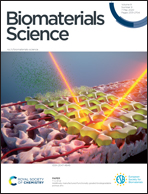Engineering red-emitting multi-functional nanocapsules for magnetic tumour targeting and imaging†
Abstract
In this work we describe the formulation and characterisation of red-emitting polymeric nanocapsules (NCs) incorporating superparamagnetic iron oxide nanoparticles (SPIONs) for magnetic tumour targeting. The self-fluorescent oligomers were synthesised and chemically conjugated to PLGA which was confirmed by NMR spectroscopy, FT-IR spectroscopy and mass spectrometry. Hydrophobic SPIONs were synthesised through thermal decomposition and their magnetic and heating properties were assessed by SQUID magnetometry and calorimetric measurements, respectively. Magnetic nanocapsules (m-NCs) were prepared by a single emulsification/solvent evaporation method. Their in vitro cytotoxicity was examined in CT26 colon cancer cells. The formulated fluorescent m-NCs showed good stability and biocompatibility both in vitro and in vivo in CT 26 colon cancer models. Following intravenous injection, accumulation of m-NCs in tumours was observed by optical imaging. A higher iron content in the tumours exposed to a magnetic field, compared to the contralateral tumours without magnetic exposure in the same animal, further confirmed the magnetic tumour targeting in vivo. The overall results show that the engineered red-emitting m-NCs have great potential as multifunctional nanocarriers for multi-model bioimaging and magnetic-targeted drug delivery.



 Please wait while we load your content...
Please wait while we load your content...